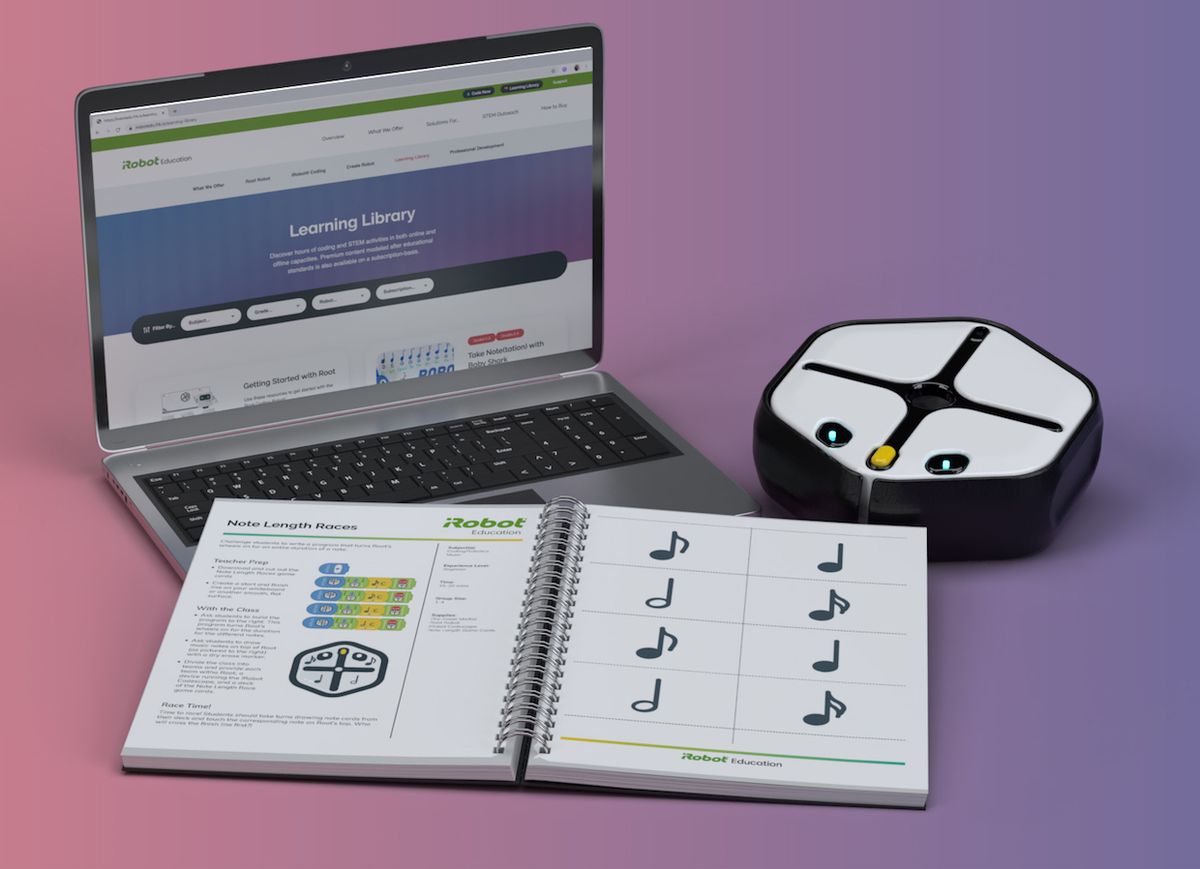About a year ago, iRobot acquired Root Robotics to help them with a major push for developing STEM education. It wasn’t just Root’s educational robot itself, but also their platform, which included software and lessons for helping kids learn how to code. Today, as part of the National Robotics Week in the United States that almost everyone seems to have forgotten about, iRobot is announcing iRobot Education—a combination of an online robot simulator along with lessons and activities that your kids (or you yourself) can use completely for free.
We’re already familiar with (and fans of) the Root coding robot, which is a great intro to coding and robotics but costs US $200. Root is likely a bit more practical for educational institutions (primary and secondary schools) that can afford to buy a handful of them to support several classrooms worth of kids, making it much more cost effective. But for individual students, or for kids who are, say, stuck at home during a pandemic and need to stay busy and/or educated, buying a robot like Root is a big investment. Fortunately, they can just do what every other roboticist does when they don’t have access to hardware: Start in simulation instead.
iRobot is launching a free (albeit proprietary) coding and simulation platform that’s compatible with most operating systems, including Android, Chrome OS (Chromebooks!), Windows, iOS, and macOS. Called iRobot Coding, it has a lot in common with coding frameworks like Blockly and Scratch, in that there are several levels of complexity to help make it super easy to start even if you’ve never coded before. The simplest level has blocks that you drag and drop into a framework that structures your code for you. Level 2 adds variables and logic functions into the mix. And Level 3 replaces the blocks with text, although text that’s still fairly user-friendly. You can switch between all three levels whenever you like, even if it’s the same piece of code, effectively translating something simple (with fewer options) into something complex (with more options), which is a great way to progress.

What’s really unique about iRobot Coding is that the coding environment includes an integrated Root simulator, meaning that the code you write can control a little simulated robot. It’s a simplified 2D representation of an actual Root robot, with many of the same (simulated) capabilities, including bumpers, pattern sensors, touch sensors, lights, and even a pen that can draw on the simulated whiteboard that the simulated robot is running on.
It’s incredibly fast and intuitive to get the little simulated Root zipping around doing stuff, and if you do end up having access to a physical Root robot, anything you develop in the simulated environment will transfer right over. While the simulator doesn’t include obstacles, iRobot is planning on adding some environments (like mazes) to challenge your programming abilities. What it does include is the ability for the simulated robot to recognize, and react to, the lines that it draws, which is an opportunity to do some clever programming.

“One of the wonderful things about robots is that you speak to them through code, and you speaking to them through code is a form of problem-solving,” says Zee Dubrovsky, senior director and general manager of Educational Robots at iRobot. “The robot will only do what you code it to do and so if it’s not doing what you expect, it’s not because you didn’t imagine something correctly, it’s that you have to translate your problem-solving into the code. And it’s those learning opportunities that are critical.”
Perhaps just as important as iRobot’s coding and simulation tool is the support behind it, in the form of activities and lesson plans that provide guidance and structure. There are code samples as well as a pile of downloadable PDF lessons, some of which are modeled after educational standards (like Common Core). We’re told that there will soon be hundreds of hours of content available, although since the site just launched this morning, things may be a bit sparse if you go look right at the moment.
iRobot says that they’ve been working on this for a year, and it’s just a coincidence that they’re releasing it at a time when lots of parents are desperate to find ways of keeping their kids educated and entertained at the same time. With that in mind, they’ve made their premium lessons (the ones designed for teachers) free until June with the code “LEARN.” After June, access will be $5 per month.
Going forward, iRobot has some ambitious plans to build on this initial STEM educational framework. “iRobot coding will one day extend simulated Roombas, where instead of Root’s marker up and down, you’re coding Roomba’s vacuum on and off,” says Dubrovsky. “Eventually, we’ll have a connection to the physical robots as well—it’s certainly within our capability, and that’s something we’re excited about.”
Us too!
[ iRobot Education ]
Evan Ackerman is a senior editor at IEEE Spectrum. Since 2007, he has written over 6,000 articles on robotics and technology. He has a degree in Martian geology and is excellent at playing bagpipes.



